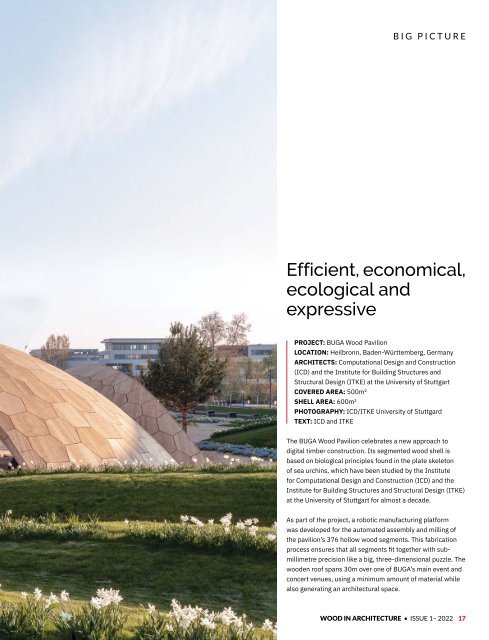Wood In Architecture Issue 1, 2022
First published in 2017, Wood in Architecture (WIA) is a bi-annual trade magazine devoted to the international timber construction sector. The newest addition to the Panels & Furniture Group of wood magazines, WIA features in-depth insights to the latest industry news, incredible projects and leading trade events. WIA is an advocate for timber as a material of choice for today’s built environment, and is the perfect source of inspiration for architects, builders, engineers and interior designers across the globe.
First published in 2017, Wood in Architecture (WIA) is a bi-annual trade magazine devoted to the international timber construction sector. The newest addition to the Panels & Furniture Group of wood magazines, WIA features in-depth insights to the latest industry news, incredible projects and leading trade events. WIA is an advocate for timber as a material of choice for today’s built environment, and is the perfect source of inspiration for architects, builders, engineers and interior designers across the globe.
Create successful ePaper yourself
Turn your PDF publications into a flip-book with our unique Google optimized e-Paper software.
BIG PICTURE<br />
Efficient, economical,<br />
ecological and<br />
expressive<br />
PROJECT: BUGA <strong>Wood</strong> Pavilion<br />
LOCATION: Heilbronn, Baden-Württemberg, Germany<br />
ARCHITECTS: Computational Design and Construction<br />
(ICD) and the <strong>In</strong>stitute for Building Structures and<br />
Structural Design (ITKE) at the University of Stuttgart<br />
COVERED AREA: 500m²<br />
SHELL AREA: 600m²<br />
PHOTOGRAPHY: ICD/ITKE University of Stuttgard<br />
TEXT: ICD and ITKE<br />
The BUGA <strong>Wood</strong> Pavilion celebrates a new approach to<br />
digital timber construction. Its segmented wood shell is<br />
based on biological principles found in the plate skeleton<br />
of sea urchins, which have been studied by the <strong>In</strong>stitute<br />
for Computational Design and Construction (ICD) and the<br />
<strong>In</strong>stitute for Building Structures and Structural Design (ITKE)<br />
at the University of Stuttgart for almost a decade.<br />
As part of the project, a robotic manufacturing platform<br />
was developed for the automated assembly and milling of<br />
the pavilion’s 376 hollow wood segments. This fabrication<br />
process ensures that all segments fit together with submillimetre<br />
precision like a big, three-dimensional puzzle. The<br />
wooden roof spans 30m over one of BUGA’s main event and<br />
concert venues, using a minimum amount of material while<br />
also generating an architectural space.<br />
WOOD IN ARCHITECTURE • ISSUE 1– <strong>2022</strong> 17


















